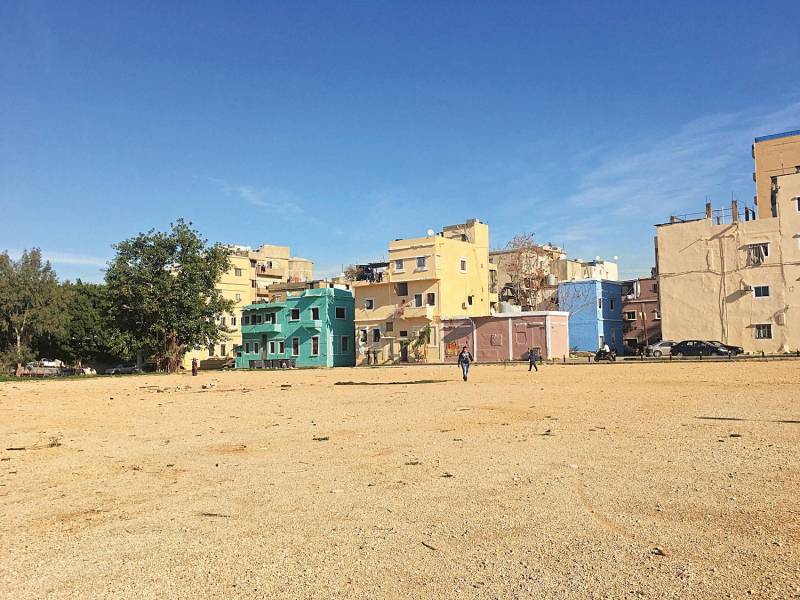Real estate is expensive in Beirut because land is scarce. This belief, regularly rekindled by the banking and real estate communities, is based on the notion that the lack of land available for new developments increases the value of available land, and therefore, the value of real estate. This collective myth, which one typically encounters in small countries, is misleading.

Many professionals justify the high price of real estate in Beirut by citing land scarcity. However, vacant and temporarily occupied plots are not lacking in the capital. In fact, vacant lots and car parks occupy an important place in the city’s urban landscape, reminiscent of North American city centers, which are perforated by what urban planners call wastelands.
Some estimates, although they are difficult to verify, suggest that of more than 20,000 plots of land within municipal Beirut, about 7,000, or one-third, can be considered empty and are technically suitable for development. Crumbling old buildings (excluding heritage buildings) that are sometime unoccupied or under-occupied, and could easily be demolished, can also be added to this impressive number. It is therefore difficult to say that Beirut suffers from a lack of lots to build.
Relative scarcity
Rather than being a phenomenon of absolute scarcity, this perception held by the real estate community regarding alleged land scarcity seems to reveal another reality: that of a relative paucity stemming from competing economic behaviors and interests as well as complex legal realities.
Over the past fifteen years, the leading real-estate developers in the capital, those who shape major market trends, have devoted a great deal of their activity to the construction of luxury condominium towers. To this end, they have sought large plots of land, with a minimum surface area of 4,000 square meters, or smaller parcels to agglomerate in order to benefit from the “Grands Ensembles” regulation in the Lebanese building law that allows the maximization of floor area, and thus of profit.
However, finding large plots that are easily tradable and reasonably priced has proven to be a complicated quest. Aware of this trend and under pressure from an atmosphere rife with the kind of speculation that comes with every real estate boom, the majority of landowners, who also want their share of the cake, have often made excessive pricing demands, especially since they have no incentive to sell quickly since unbuilt land is not subjected to any tax. But in parallel with this financial aspect, many plots have complex or uncertain legal situations (for example joint ownerships or public or religious property) that are likely to complicate or even prevent transactions.
These competing economic interests between developers and landowners, in addition to the legal complications, have contributed to promoting the idea of land scarcity in Beirut. At the same time, a number of real estate developers have spread false information in the press, claiming, at the height of the boom, that there wasn’t enough land to build on, in order to encourage customers to buy apartments as soon as possible.
The scarcity of land in Beirut is therefore a relative issue: there is no lack of land in terms of quantity, but there is a lack of large affordable land to meet the very specific demands of developers. In other words, this perception of scarcity is above all a matter of price.
Land and real estate markets
A second belief, also driven by the myth of land scarcity, considers the exorbitant prices of real estate in the capital as the consequence of soaring land prices, itself due to the alleged lack of land for construction activity. This idea is actually based on a major bias in the analysis of real estate pricing in general, and the articulation of land and real estate markets in particular. Multiple empirical studies conducted in many cities around the world have shown that, in the medium and long term, residential property prices mostly reflect the trajectory of real estate demand and determine land prices.
In Beirut, the spectacular growth in the prices of both recently built and existing real estate over the last fifteen years, despite a downward trend since 2014, is first and foremost the result of strong resident and non-resident demand, composed of both investors and end users.
Real estate demand in Lebanon is recurrently high, albeit in decline in recent years, thanks to a series of factors, including: a tax and legislative environment particularly favorable to property investment; a high level of external money supply (particularly during the 2000’s financial boom); and housing loan programs significantly subsidized by the central bank. Given the inelasticity of supply in the floor area in the short term, sustained demand has fuelled real estate prices during boom years, which ended more or less between 2010 and 2012.
It also prevented a sharp fall in prices in the stagnation period that followed. Furthermore, albeit to a lesser extent, market opacity (lack of a price indicator) and the significant, but difficult to quantify, use of real estate assets for money laundering and tax fraud have helped keep real estate prices afloat.
These elevated real estate prices, associated with a virtual absence of land governance (minimal planning and zoning constraints and inadequate property taxation), very much shape land prices, and not the other way around. This occurs through three mechanisms well known to economists: the calculation of residual land value, the multiplier effect of real estate prices on land prices and the ratchet effect of land prices. Of both an economic and psychological nature, these mechanisms are critical to understanding the actual workings of land and real estate markets.
Economic mechanisms
The establishment of residual land value is common practice in the real estate industry. Before taking the decision of starting a new development, professional developers calculate the amount that can be invested in a land purchase by deducting development costs (i.e. construction and financial costs, taxes, etc.) and expected profit from the project’s current market value.
This first mechanism governing economic decisions made by real estate professionals is then a critical link connecting real estate and land markets.
The second mechanism is the multiplier effect of real estate prices on land prices during the upward swing of a property cycle, as was the case throughout the 2000s in Beirut. At roughly steady financial and construction costs, an increased amount of cash becomes available for land acquisition when a surge in demand boosts real estate prices. In other words: the higher real estate prices are the higher the amount developers will spend on land. This phenomenon very much contributes to putting land prices on the rise.
Available estimates on the evolution of Beirut land and real estate prices in the 2000s, which should be considered with caution due to the absence of any official price index, accurately illustrate this phenomenon: while real estate prices increased by about 200 percent between 2003 and 2013, land prices surged by 600 percent between 2005 and 2012. This multiplier effect has significantly influenced the economic behavior of landowners in the short and medium term: their financial expectations never ceased to inflate for assets whose value is perceived as continuously on the rise.
Lastly, the ratchet effect of land prices is the third mechanism explaining the relationship of real estate to land markets. It reflects the downward stickiness of land prices when real estate activity and prices stagnate or slightly decrease, as it has been the case in Beirut in recent years. After years of hyperinflation, the price of land takes longer to deflate since it is a better value-preserver and an intermediary good with low storage costs.
Landowners refuse to revise their return expectations downwards and choose to keep prices high in the hope that they will pick up again. These "effects of collective psychology", unpacked by economists like Robert Shiller and Vincent Renard, contribute to reinforcing the perception of land scarcity. In the context of economic and real estate stagnation, the prices asked by property owners are indeed higher than the amount developers are willing to pay for land.
The myth of land scarcity in Beirut, and its assumed role in the exuberant surge of real estate prices, is based on erroneous empirical and analytical assumptions. It also implicitly reflects the misunderstanding of some of the key economic mechanisms and behaviors that underlie the episodes of real estate frenzy frequently observed in the Lebanese capital. The scarcity of land is socially constructed, shaped by the choices and strategies of economic actors, rather than by any kind of ‘spatial determinism’. Under these conditions, the limited access land developers in Beirut complain about is not set in stone: many legal and financial instruments exist to streamline land supply. The latter should be implemented as part of a larger land policy reform aimed at organizing urban development in general and at regulating price inflation in particular.
The article was originally published in French







